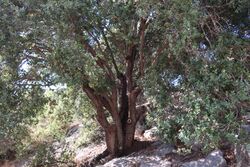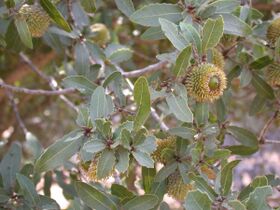Biology:Quercus calliprinos
| Palestine oak | |
|---|---|

| |
| Scientific classification | |
| Kingdom: | Plantae |
| Clade: | Tracheophytes |
| Clade: | Angiosperms |
| Clade: | Eudicots |
| Clade: | Rosids |
| Order: | Fagales |
| Family: | Fagaceae |
| Genus: | Quercus |
| Subgenus: | Quercus subg. Cerris |
| Section: | Quercus sect. Cerris |
| Species: | Q. calliprinos
|
| Binomial name | |
| Quercus calliprinos Webb
| |

| |
Quercus calliprinos is an oak classified as part of the Cerris section of the genus growing in the Mediterranean climate zone, mainly on limestone, in mid-elevations, often dominating the flora, alongside terebinths (Pistacia terebinthus).[1].
It is native to eastern Mediterranean region and southwest Asia, and grows in the Levant, North Africa to Anatolia and further eastwards. In Israel it is called the common oak (Hebrew: אלון מצוי, IPA: [a'lon ma'tsuj]) or the Palestine oak.
Description
Quercus calliprinos is a small to medium-sized tree or large shrub reaching 5–18 metres (16–59 feet) tall (often only 1–3 m tall where heavily browsed by goats) and 1 m in trunk diameter. It is evergreen, with spiny-serrated leaves 3–5 centimetres (1 1⁄4–2 inches) long and 1.5–3 cm broad. The acorns are 3–4 cm long and 2–3 cm diameter when mature (about 18 months after pollination), held in a cup covered in dense, elongated, reflexed scales.
Quercus calliprinos is closely related to the Kermes oak (Q. coccifera) of the western Mediterranean, and is treated as a subspecies or variety of it by some botanists. The Kermes oak is distinguished from it by its smaller size (usually shrubby, not over 10 m or 33 ft) and smaller acorns less than 2 cm diameter.
References
- ↑ Zohary, M. "The maquis of Quercus calliprinos in Israel, Palestine, and Jordan." Bulletin of the Research Council of Israel 9.2 (1960): 51-72.
Wikidata ☰ Q2666806 entry


